DEPARTMENT OF SPEECH, HEARING & PHONETIC SCIENCES UCL Division of Psychology & Language Sciences |
 |
My phonetic blog archive: March 2006
John Wells
email:
- Friday 31 March 2006
- Thursday 30 March 2006
- Wednesday 29 March 2006
- Tuesday 28 March 2006
- Monday 27 March 2006
- Saturday 25 March 2006
- Friday 24 March 2006
Michael Ashby’s presentation at the Teaching and Learning Conference yesterday was excellent. As well as explaining the kinds of things we do in practical phonetics classes, he demonstrated various interactive bits of classroom technology.
One demonstration involved getting a member of the audience (José Mompeán, planted there for the purpose) to pronounce into a radio microphone the Spanish word carrera [kareɾa], in which there is first a trill and then a tap. Seconds later we heard it played back and saw its waveform and spectrogram displayed on the big screen, using Mark Huckvale’s brilliant little free programme WASP. We could clearly see four interruptions for the trill and a single interruption for the tap.
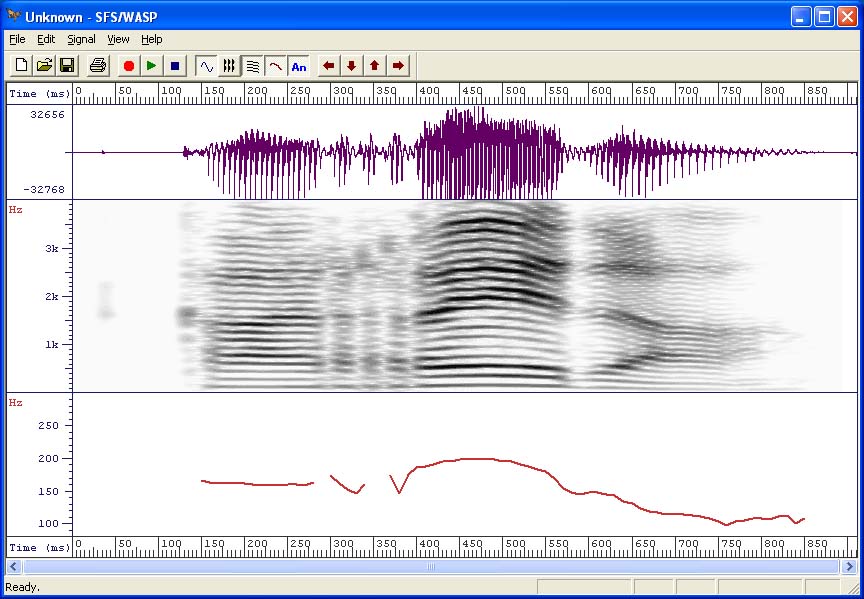
Michael also demonstrated, live, the labiodental flap with its new symbol (25 March). And he showed how the teacher can use a graphics tablet to annotate Powerpoint slides, for example in immediate response to student questions or to compare and contrast while doing ear-training.
In response to my posting a week ago, two correspondents have sent me their own favourite intonation minimal pairs.
From Canada, Ian Wilson of UBC offers
| (i) What’s for dinner, mother? |
| (ii) What’s for dinner? | Mother? |
—where (ii) actually has not only the intended cannibalistic reading (‘is dinner mother?’) but also another reading similar to (i) in which Mother is vocative, alerting her to the need to answer.
Michael Vaughan-Rees’s example comes from The Simpsons, where Bart and Lisa are pitted against each other in some sort of combat. The audience are equally divided in their support, half yelling ‘Kill Bart!’, the rest shouting ‘Kill, Bart!’.
This pair actually depends on tonicity rather than tonality: Kill Bart! vs. Kill, Bart!. A parallel example I have sometimes used is Shoot, Beckham! vs. Shoot Beckham!.
Today and tomorrow UCL is holding a Teaching and Learning conference. Our students are staffing an exhibition stand, and tomorrow at 12:40 Michael Ashby will be giving a talk on Computer and IT augmentation of practical phonetics training.
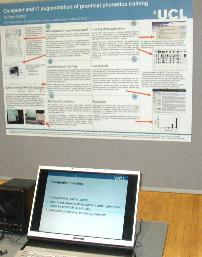 Our stand |
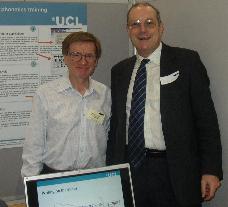 Michael Ashby and me |
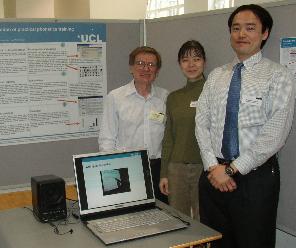 Michael Ashby, Kayoko Yanagisawa, Daisuke Yamazaki |
Last week I was brought in as one of the oral examiners for our MSc Speech and Language Sciences postgraduates (people I was not personally involved in teaching).
There were three parts in their oral test: labelling and production, substitutions, and intonation. For the first, the candidate were shown two symbol strings, CVC and VCV, for example [qaʘ] and [œɴu]. They had to identify each symbol, supplying voice, place and manner labels for consonants and height, advancement, and rounding labels for vowels. Then they had to perform the string, i.e. utter it aloud.
In the second part the examiner performed two English -VCV- words in which the medial consonant had been replaced by a succession of sound-types which the candidate had to identify by a VPM label, e.g. yellow pronounced with [ɾ], [ǃ], [ɬ], [ɠ], [ɻ] instead of [l].
For the third part the candidate was shown an English monosyllable with a range of tone marks attached. The examiner chose one (e.g. low-fall) and asked the candidate to perform it. Then the examiner performed a different one (e.g. fall-rise) and asked the candidate to identify it. Next the candidate was given an English sentence in orthography and asked to say it aloud in any way s/he chose. The task was to identify the intonation pattern used (one mark for nucleus location, one for nuclear tone, and one for any other stressed/accented syllables). Finally the examiner performed an intonationally different version of the same sentence, and the candidate had again to identify the intonation pattern.
Altogether this was quite a tough test. I was impressed by how well the candidates performed after a mere six months doing phonetics, particularly as compared to our BSc undergraduates. (Both programmes lead to a qualification as a Speech and Language Therapist.)
Thanks to Michael Ashby, here’s a picture of last Thursday’s celebrations: you see me surrounded by the MA Phonetics students (l to r: José Mompean, Hisako Sokei, Xiangyan Sun, Aki Hirose, Kimmie Ip, Hiroyuki Oda, me, Ryutaro Inoue, Daisuke Yamazaki). Click to enlarge
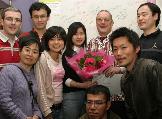
The Hawaiian shirt was my attempt to add a note of carefree retirement ethos on top of my ordinary working clothes.
The IPA has recently approved a new phonetic symbol, to represent a voiced labiodental flap. It is like a letter v, but with a hook on the righthand side. If you have installed one of the new SIL Unicode phonetic fonts you should be able to see it here: . It does not (yet) have an official Unicode number, so the SIL people have placed in the Private Use area with the number U+F25F.
Here’s a gif so that you can see what it looks like even without installing fonts.

The two fonts that contain this symbol, along with all the other official IPA symbols and a generous helping of non-IPA symbols, are Charis SIL and Doulos SIL. You can download them free from the links given. (You will then need to unzip the files and install them.)
Early versions of Doulos SIL did not contain the symbol. Nor does Lucida Sans Unicode. Nor, of course, did any of the old single-byte fonts such as SIL Doulos or the ipa-sam fonts that I developed many years ago.
SIL also offers Mac users, who rather got left behind as far as Unicode is concerned, a keyboard facility called Ukulele that will enable them to insert all the Unicode symbols they need. Users of Word/Windows don’t really need any such extra software, since they can immediately “see” all installed Unicode characters with Insert Symbol, and quickly create macros using AutoCorrect. However, for those who like a keyboard facility, SIL offers one called Keyman. My colleague Mark Huckvale has made a rather simpler one called simply Unicode Phonetic Keyboard, which you can download from here.
Today is the last day of the second term at UCL, which means the last day of formal lectures and classes for the academic year. The third term is devoted to revision and examinations.
Both Neil Smith (Professor of Linguistics) and I will be retiring this year. So yesterday the students organized a small celebration, with wine and food, in our honour. My colleague Michael Ashby said kind things about my career, while also pointing out — quite correctly — that success in academia does not depend crucially upon an ability to keep one’s office tidy. The undergraduates gave me a farewell card and some chocolates, while the MA Phonetics students came up with a large bouquet of flowers and a monster card with a group photo and a message in faultless phonetic transcription. Deirdre Wilson spoke in praise of Neil Smith, and he too received a presentation. Then came a ‘guest appearance by Tim Cody’, aka Tim Wharton, research fellow in pragmatics. He accompanied me on the guitar while I sang (or attempted to sing) the Jim Reeves number He’ll have to go. Then he himself sang Neil’s choice, Robert Palmer’s Addicted to Love. Altogether a very moving send-off.
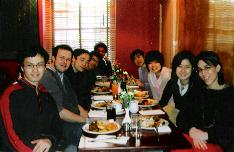
The 2005-2006 UCL MA Phonetics students, with Volker Dellwo
Click to enlarge
my home page